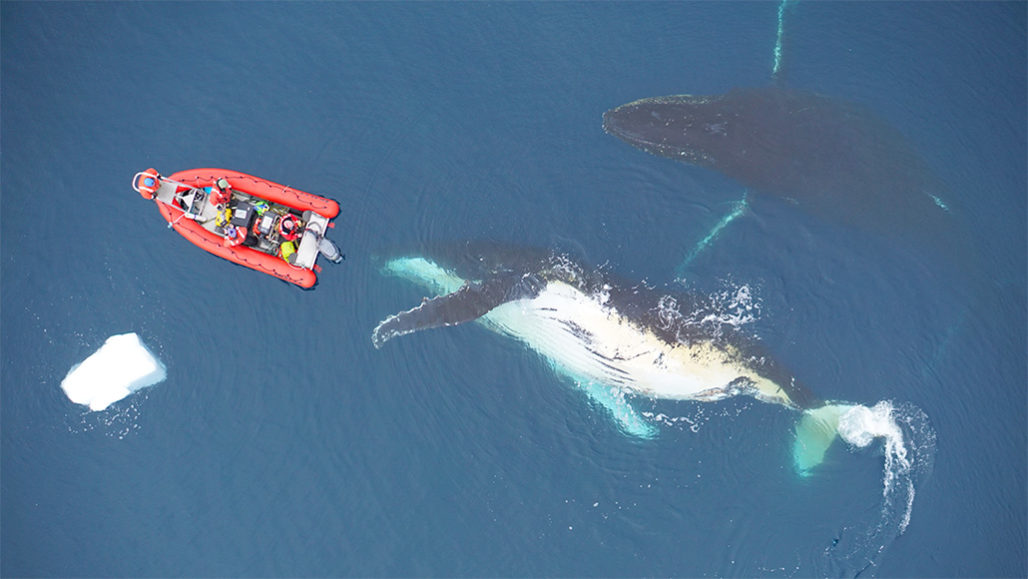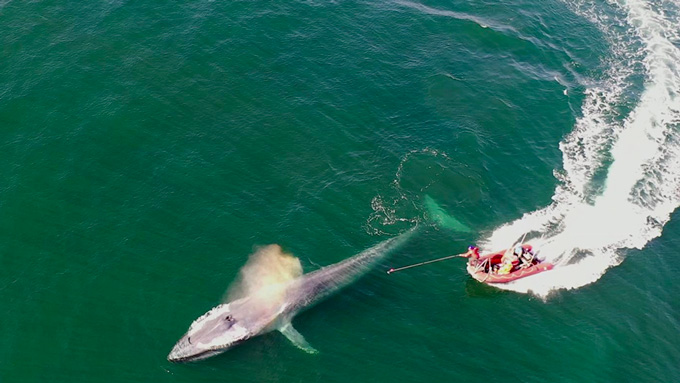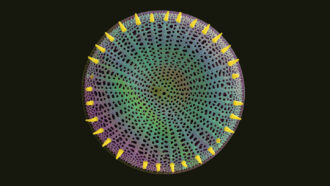Why some whales become giants and others are only big
How big the animals get depends on how they hunt and what they eat

Scientists attached sensors to more than 100 individual whales, such as these two humpbacks near Antarctica in 2018. The researchers tracked the whales for more than a decade to study dining behaviors and body size.
Goldbogen Lab./Stanford Univ., Duke Univ. Marine Robotics and Remote Sensing. Photo taken under permit ACA/NMFS #14809
Sensors suction-cupped onto whales’ backs are helping biologists answer two big questions. Why are whales so large? And why aren’t they bigger?
Being big can boost the ability of whales to reach more food and with less effort. That can help them access deep-sea prey that would be beyond the reach of many other creatures. In a new study, scientists estimated how much energy 13 species of whales and porpoises use — and gain — when foraging. They conclude that how big the creatures get depends on how and what they eat and how much food they can find.
Jeremy Goldbogen works at Stanford University in California. As a comparative physiologist (Phiz-ee-OL-oh-gist), he studies how the bodies of animals work. He specializes in whales. For the new study, he worked with a large team of researchers to learn how whale size relates to what whales eat and how they get it.
Toothed whales, such as orcas, echolocate (Ek-oh-LOW-kayt) to hunt for individual prey. The whales’ size appears to be limited by how much food they can grab during one dive, the researchers report. That’s not the case, though, for blue whales and other filter feeders. They open their mouths wide and bring in a large gulp of water — along with whatever is in it. Then they shove the water back out between big baleen plates. Afterward, they swallow the food caught behind those plates.
These animals tend to be much larger than their toothed cousins. Filter feeders alive today aren’t constrained by food availability. So they might be limited by other factors, such as how large a body they can physically support. These animals might even be on their way to evolving to become bigger still, the team suggests in the December 13 Science.
“This is a fascinating study,” says Samantha Price. She is a biologist at Clemson University in South Carolina who studies how animals’ bodies have evolved. She was not part of the new research. Biologists have been thinking about the evolution of bigness for a long time, Price says. These researchers, “through incredible effort, actually got some data about these hard-to-study behaviors,” she notes.

Educators and Parents, Sign Up for The Cheat Sheet
Weekly updates to help you use Science News Explores in the learning environment
Thank you for signing up!
There was a problem signing you up.
In the last 5 million years, whales have become larger than ever, Goldbogen says. The blue whale grew into the largest creature ever throughout the history of life. He says that could be due to changes in glacial cycles, winds — even ocean currents. Those changes have focused upwellings of nutrients in pockets of the sea. The nutrients attract dense patches of tiny crustaceans, fish and other animals. And that creates whale buffets.
Being large has helped whales exploit such food bonanzas in a few ways. Bigger creatures can travel farther using less energy per unit of mass. So big whales can cross wide swaths of barren ocean to reach food-rich upwellings. Larger bodies also support larger lungs. And more air means more time for feeding during dives.
Simply put, bigger whales were thought to be more efficient at finding food, Goldbogen says. But that was mostly just an educated guess, he adds. Researchers didn’t have good data about how much energy whales gained from food or used while diving and hunting. “We just didn’t know much about what these animals were actually doing underwater,” he explains.
Whale trackers
Goldbogen and an international team of researchers worked to change that. They employed technology-packed sensors. The researchers used suction cups to stick the sensors to the backs of whales. In all, the team attached sensors to 300 whales. These belonged to 13 species. They ranged from 50-kilogram (110-pound) harbor porpoises to 150,000-kilogram (330,000-pound) blue whales. Over a decade, the team tracked more than 10,000 feeding events. “It was no small task,” Goldbogen says.
The tags relayed data that became a daily diary of the whales’ activity. Pressure sensors and accelerometers tracked the whales’ movements and depth. Hydrophones recorded sounds. These included the clicks and buzzes used to hunt and socialize. And cameras captured video of the animals’ surroundings. All together, these data helped the researchers tell when filter-feeding giants opened their mouths to lunge at swarms of krill. They could show when sperm whales echolocated an octopus. And they allowed the researchers to gauge how much energy different species use on each dive.

The team also captured sonar readings of prey density. They even dissected the stomach contents of stranded whales. That info, plus data from the tags, painted a detailed picture of what different whales ate. Then the researchers calculated an energy budget for each species. That refers to how much energy an animal has to spend to get food and how much it gains from eating that food. Such budgets help show how foraging efficiency relates to body size.
Toothed whales usually hunt squid or octopus. Being big helps these whales dive deep to access more food, the researchers found. But after a point, their foraging efficiency falls with increased size. True, a giant squid offers a lot of fuel. But such prey are few and far between. What’s more, finding them takes a lot of energy. There just aren’t enough in the ocean for the whales to get any bigger, Goldbogen says.
In contrast, bulk filter feeders get more efficient with size. These eaters target dense swarms of tiny krill and other crustaceans. In a single gulp, the whales can get a huge number of calories. (Goldbogen says calculations suggest more than 10 million of them!) And it takes less effort than chasing down a squid. So blue whales and other filter feeders may not be limited by a lack of prey. Instead, their top body size may be due to other factors. Maybe it’s how far a whale heart can pump blood, or how large a jaw can grow. The study didn’t look at such factors or try to figure out what the physical limits on their growth might be. But it may not be possible physically to engulf more krill than big whales already do.
Or it’s possible the size of these ocean giants might not be limited at all. The creatures might still be evolving to get even bigger. That could be true as long as populations of krill stay abundant. Speculates Goldbogen, “Perhaps, millions of years from now, we’ll see even bigger ocean giants.”







